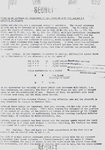The Bf-109Z actually never flew so what kind of problems it had will never be known. The only prototype built was damaged in an air attack while on the ground.
Bf-109Z
Here is another interesting Me-109 conversion that also never made it being canceled when the Me-262 came online.
Me-109TL
Bf-109Z
The Messerschmitt development department received a directive in 1942 to begin work on a Zerstörer (destroyer, or heavy fighter). An earlier RLM directive of 1941 had tried to limit the amount of new designs coming from the major aircraft companies (to not disrupt the production lines with new aircraft), so it was decided to couple two Bf 109 fuselages together, along with a new center wing and tailplane section, to come up with the Me 109Z (Zwilling, or twin).
The Me 109Z prototype incorporated two Bf 109F-4 fuselages, joined with a new constant chord wing center section and parallel chord tailplane. Included also was the 109F-4 powerplant, the Daimler Benz DB 601E-1 engine (12 cylinder, liquid-cooled, inverted V - 1750 horsepower on takeoff). The main landing gear attachment point were moved inboard to attach to a strengthened centerline keel in each fuselage. The outermost main landing gear retracted outboard; the inner legs retracted into the new center wing section. A single pilot sat in the port cockpit and the starboard cockpit was faired over. Armament on the projected production models varied (see below).
Several other Me 109Z designs were planned, developed around the 109G fuselages. The Me 109Z was to use around 90% of pre-existing 109 parts, with only the new main wing and tailplane, modified landing gear mountings, slightly larger wheels, extra fuel tanks in place of the starboard cockpit and a few other components needed to complete the aircraft. A prototype was completed in early 1943, but it was damaged in an Allied air attack on the Messerschmitt test center, and the damage was deemed too severe for repair. The development was abandoned in 1944, and by then, the Me 262 jet fighter had taken wing. One interesting note: the North American aircraft company followed the same design (independently) to produce the P-82 Twin Mustang, which was two P-51 fuselages joined in a similar manner as the Me 109Z.
Span: 13.27 m 43' 6"
Length: 9.048 m 29' 8"
Height: 2.69 m 8' 10"
Empty Weight: 6000 kg 13224 lbs
Loaded Weight: 7280 kg 16050 lbs
Max. Speed: 743 km/h @ 8000 m 462 mph @ 26250'
Cruising Speed: 570 km/h @ 3000 m 354 mph @ 9840'
Service Ceiling: 11700 m 38385'
*Obviously the Speed stats and the Ceiling stats can not be confirmed as the aircraft never flew.
Me 109Z Prototype
Fuselage: 2 x Bf 109F-4
No armament
Engines: 2 x DB 601E-1
Me 109Z-2 Bomber
Fuselage: 2 x 109G-6
Armament: 2 x MK 108, 2 x MK 103
1 x 500 kg bomb
Engines: 2 x DB 605A-1
Me 109Z-3 Zerstörer
Fuselage: 2 x Bf 109H-2
Armament: 4 x MK 108, 1 x MK 103
1 x 500 kg bomb
Engines: 2 x Jumo 213E
Me 109Z-4 Bomber
Fuselage: 2 x Bf 109H-2
Armament: 2 x MK 108, 2x 1000 kg bombs
Engines: 2 x Jumo 213E
http://www.luft46.com/mess/me109z.html
Here is another interesting Me-109 conversion that also never made it being canceled when the Me-262 came online.
Me-109TL
The Messerschmitt 109 Turbo-Lader Strahltriebwerk ( turbocharger jet engine) was proposed on January 22, 1943 at an RLM conference as a back-up for the Me 262, of which only three prototypes had been completed at the time. In order to cut down on design and production time, various components from existing aircraft was to be used. The fuselage from the Me 155B high-altitude fighter was to be used (with a new nose and tail section), the wing was from the Me 409 project and the undercarriage came from the Me 309. The armament was to be two MG 151/20 20mm cannon (120 rounds each) and two MK 103 30mm cannon, all in the nose. A later proposal included two MK 108 30mm cannon could be installed in the wing roots. The performance was estimated to be better than the Me 262 due to the Me 109 TL's narrower fuselage. Following intensive study, by March 1943 it was decided that so many modifications to the various components would be needed that no time would be gained over the Me 262 development, thus the project was abandoned.
Span: 12.55 m (41' 2")
Length: 9.5 m (31' 2")
Max. Speed: 980 km/h (609 mph)
*Speed cannot be confirmed again as aircraft never flew.
http://www.luft46.com/mess/me109tl.html





